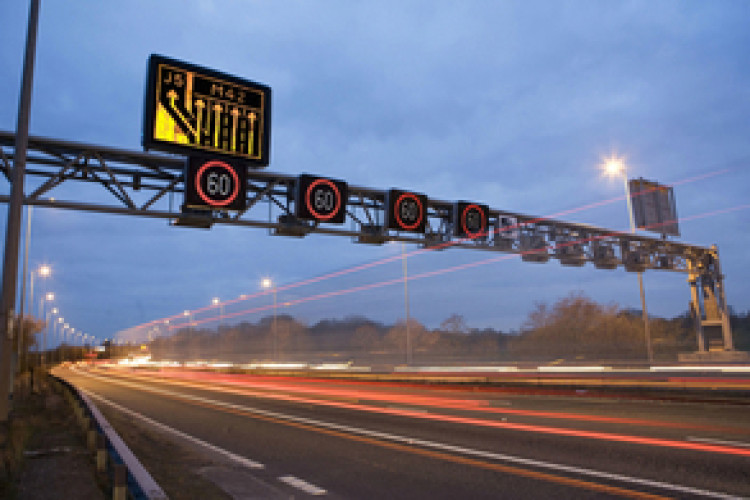The plan of action includes abolishing ‘dynamic hard shoulder’ motorways – those that open hard shoulders to traffic only during busy times – and building more emergency refuge areas on the M25.
No decision has yet been taken about putting in more refuge areas on other motorways but it is being considered, he said.
He has also instructed Highways England to speed up the deployment of ‘stopped vehicle detection’ radar so that it is installed across the entire smart motorway network by March 2023.
Other measures include more signs telling motorists how much further they have to before it is safe to break down.
In October 2019, after substantial publicity about deaths on smart motorways, secretary of state Grant Shapps asked the Department for Transport to carry out an evidence stocktake to gather the facts on the safety of smart motorways and make recommendations.
The result, today, is the ‘18-point action plan’ listed below, although some of the 18 actions involve considering, investigating and reviewing rather than actually doing.
Transport secretary Grant Shapps said: “I’ve been greatly concerned by a number of deaths on smart motorways, and moved by the accounts of families who’ve lost loved ones in these tragic incidents. I commissioned an urgent stocktake of smart motorways to provide a clearer picture of their safety and make recommendations on next steps. I envisaged it to be swift, but during the course of our investigations a complex picture emerged – which warranted further work.
“That work has now concluded and overall, evidence shows that in most ways smart motorways are as safe as or safer than conventional ones. But I am clear that there is more we can do to raise the bar on smart motorway safety. The extended package of measures I have set out will help rebuild public confidence in our motorway network and ensure that safety is firmly at the heart of the programme.”

Highways England chief executive Jim O’Sullivan said: “Every death in any road accident is tragic, and we are determined to do all we can to make our roads as safe as possible. We will be taking forward the measures the secretary of state for transport has set out, and we will be improving further our information to drivers to help them be safer on all of our roads, including our smart motorway network.”
Motoring organisations endorsed the plan of action. AA president Edmund King said: “For the last decade we have been campaigning to improve the design and safety of ‘smart’ motorways. The measures announced by the transport secretary today are a victory for common sense and safety.
“The original M42 managed motorway pilot in 2006 with emergency refuge areas (ERAs) every 500 metres worked well but after that the goalposts were moved and the roll-out began with ERAs at every 2500 metres (1.5 miles).
“We have campaigned ever since to double the number of ERAs. Today we have the commitment that moves their spacing from the original of 1.5 miles to three quarters (0.75) of a mile where feasible.
“The fact that 38% of breakdowns happen in live lanes on smart motorways means drivers have been at risk. Tragically people have lost their lives, and in some cases coroners have indicated this could have been avoided.
“No driver wants to be stuck in a live lane with nowhere to go; at best it is incredibly distressing, at worst it can be fatal. We are committed to ensuring smart motorways work for drivers and that drivers understand how to use them.
Steve Gooding, director of the RAC Foundation, said: “The stocktake appears to be a thorough piece of work, and the further measures he is proposing should be reassuring for motorists who’ve been voicing legitimate concerns about the loss of the hard shoulder from our motorways.”
That action plan:
- Abolishing “dynamic hard shoulder” smart motorways, where the hard shoulder operates only part-time and is a live running lane the rest of the time.
- Speeding up the deployment of “stopped vehicle detection” technology across the entire “all lane running” smart motorway network, so stopped vehicles can be detected and the lanes closed more quickly. Highways England is to install the technology within the next 36 months.
- Faster attendance by more Highways England traffic officer patrols on smart motorways where the existing spacing between places to stop in an emergency is more than one mile, with the aim of reducing the attendance time from an average of 17 minutes to 10 minutes.
- Reducing the distance between places to stop in an emergency to three quarters of a mile where feasible so that on future schemes motorists should typically reach one every 45 seconds at 60mph. The maximum spacing will in future be one mile.
- Installing 10 additional emergency areas on the existing M25 smart motorways on the section of smart motorway with a higher rate of live lane stops and where places to stop in an emergency are furthest apart.
- Considering a national programme to install more emergency areas where they are currently more than one mile apart.
- Investigating M6 Bromford viaduct and the M1 at Luton, Sheffield and Wakefield where there is evidence of clusters of incidents.
- Making emergency areas more visible – all emergency areas will have a bright orange road surface, dotted lines on the surfacing showing where to stop, better and more frequent signs on approach and signs inside giving information on what to do in an emergency. These will be installed by the end of spring 2020.
- More traffic signs giving the distance to the next place to stop in an emergency, so you will almost always be able to see a sign. Typically, these will be between approximately 330 and 440 yards apart.
- More communication with drivers – a £5m publicity campaign to increase awareness and understanding of smart motorways.
- Displaying ‘report of obstruction’ messages automatically on electronic signs, triggered by the stopped vehicle detection system, to warn drivers of a stopped vehicle ahead. This is currently being trialled on the M25 and then a further trial on the M3.
- Working with satnav providers to get satnavs to show emergency refuge areas.
- Working with car manufacturers to improve awareness of the use of the eCall ‘SOS’ button in newer cars to call for help when broken down.
- Revised law to enable automatic detection of ‘red X’ violations and enforcement using cameras; expanding the upgrade of smart motorway cameras (HADECS) to identify more of those who ignore the ‘red X’.
- Updating the Highway Code to provide more guidance.
- Working with the recovery industry on training and procedures.
- Reviewing existing emergency areas where the width is less than the current 15 foot standard. Narrow ones will be widened to 15ft where feasible and appropriate.
- The use of red flashing lights is being reviewed, with a view to letting recovery vehicles use them.
Got a story? Email news@theconstructionindex.co.uk



